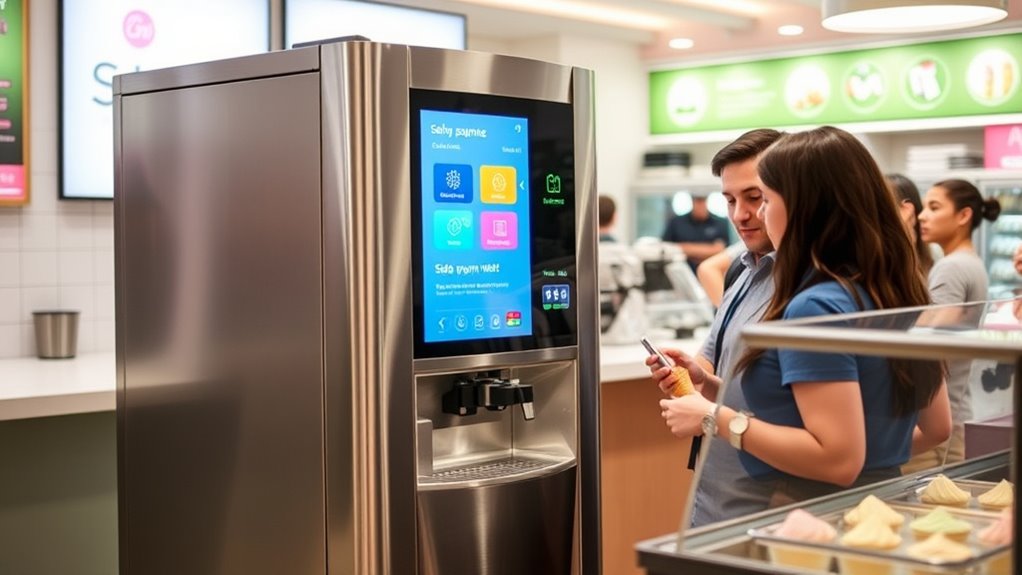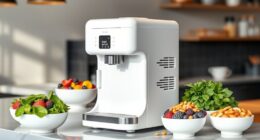Your ice cream machine can really pay for itself if you carefully weigh the initial costs, ongoing expenses, and demand in your location. Factors like installation, maintenance, and electricity impact profitability, but smart pricing and high customer flow boost sales. Regular upkeep and upgrades extend its lifespan, helping you recover your investment faster. Want to know how to maximize your returns and ensure your machine is a profitable choice? Keep exploring for expert tips.
Key Takeaways
- Rapid cost recovery depends on high customer traffic, competitive pricing, and efficient machine operation.
- Initial investment, installation, and ongoing maintenance significantly impact the timeline for profitability.
- Contactless and fast-service features can boost sales volume, accelerating the payback period.
- Regular upgrades and proper maintenance extend machine lifespan, improving long-term profitability.
- Market demand and customer willingness to pay are crucial in determining if the machine will financially justify itself.

Self-payment ice cream machines are revolutionizing how you enjoy your favorite frozen treats. These machines allow customers to serve themselves, paying directly at the point of purchase, which not only streamlines operations but also opens up new revenue streams. But before diving into this investment, you need to consider whether these machines truly pay for themselves in the long run. To do that, you should focus on a thorough investment analysis that includes evaluating potential cost recovery. Cost recovery refers to how quickly you can recoup your initial investment through the income generated by the machine. When analyzing whether a self-payment ice cream machine makes financial sense, you’ll want to account for all associated costs—purchase price, installation, maintenance, and electricity—and compare these against projected sales and customer usage patterns.
Your investment analysis should start with estimating the total upfront costs. These include the machine’s purchase price, which can vary depending on capacity, features, and brand, as well as installation expenses and any necessary modifications to your existing setup. Once in place, you’ll need to calculate ongoing costs like maintenance, supplies, and electricity. Then, project your average daily or weekly sales based on foot traffic and pricing strategies. If your location has steady customer flow, the machine can generate consistent revenue, making it easier to determine a clear timeline for cost recovery. Additionally, understanding the air quality in your environment can help you maintain optimal conditions for the equipment, ensuring longevity and performance. Moreover, assessing the cost efficiency of your investment can help you identify ways to maximize profitability and reduce waste. Furthermore, considering the market demand in your area can help you tailor your pricing and marketing strategies to maximize sales potential. Analyzing customer behavior and preferences is also crucial for setting suitable pricing and promotional strategies to attract more buyers.
Furthermore, understanding your customer base and their willingness to pay is vital. Self-payment machines often attract a broader audience because they offer convenience and allow for quick, contactless transactions. This can lead to increased sales volume, speeding up your investment recovery process. However, it’s also essential to analyze competitive pricing and market demand—if your prices are too high or if customer traffic is lower than expected, your revenue might fall short of covering costs within your desired timeframe.
Another key aspect of your investment analysis is considering the machine’s lifespan and the potential for upgrades or replacements. Even if the initial machine pays for itself within a certain period, you’ll want to plan for eventual replacement or technological upgrades to maintain profitability. Additionally, regular maintenance can prevent costly repairs and downtime, further improving your cost recovery timeline. By systematically evaluating these factors, you can determine whether your self-payment ice cream machine will become a profitable asset over time or if it’s a costly venture that might not deliver the expected return. Ultimately, a careful, data-driven approach will help you decide if this innovative setup is a smart move for your business.
Frequently Asked Questions
What Is the Average Lifespan of an Ice Cream Machine?
The average lifespan of an ice cream machine varies, but with proper maintenance, you can expect a durable machine to last around 5 to 10 years. Machine durability depends on how well you care for it, while brand reputation plays a role in overall quality. Investing in a reputable brand usually means better durability, which can save you money in the long run. Regular servicing guarantees your machine stays in top condition longer.
How Much Maintenance Does an Ice Cream Machine Require Annually?
Your ice cream machine needs more upkeep than a spaceship! On average, you’ll spend about $1,000 to $2,000 annually on maintenance costs, including regular cleanings and parts replacement. Repair frequency varies, but catching issues early can save you from costly breakdowns. Consistent maintenance keeps your machine running smoothly, ensuring it produces high-quality ice cream and helps you avoid unexpected, expensive repairs down the line.
Are There Hidden Costs Associated With Owning an Ice Cream Machine?
You might find hidden costs with your ice cream machine, like increased leisure expenses for maintenance and repairs. Storage challenges can also add unexpected expenses, especially if you need extra space or specialized equipment. These costs can add up over time, making it seem like the machine isn’t fully worth it. Be prepared for ongoing expenses beyond the initial purchase, and plan your budget accordingly to avoid surprises.
How Quickly Can I Expect to Recoup My Investment?
You can typically recoup your investment within several months, depending on profit margins and seasonal demand. During peak seasons, increased sales boost your profits, speeding up the payback period. If you maintain efficient operations and market effectively, you’ll see returns faster. Keep in mind that fluctuations in seasonal demand can extend or shorten this timeframe, but with consistent effort, your ice cream machine will soon start generating profit for you.
Does the Machine’s Capacity Affect Its Profitability?
Your ice cream machine’s capacity directly influences its profitability. A larger capacity permits you to serve more customers quickly, increasing sales and revenue. However, bigger machines often cost more and consume more energy, which can affect profit margins. You need to balance capacity with operational costs to maximize profit impact. Choose a machine that matches your business volume to ensure you get the best return on your investment.
Conclusion
Sure, an ice cream machine might seem expensive at first, but think about the savings on store-bought treats and the fun you’ll have making your own. Even if it doesn’t fully pay for itself right away, you’ll enjoy the delicious results and the entertainment it offers. Plus, you’ll impress friends and family with your homemade creations. It’s a worthwhile investment that’s worth every penny—so go ahead, indulge and savor the savings!










